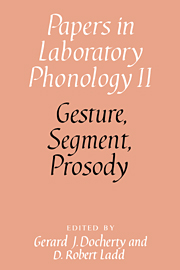Book contents
- Frontmatter
- Contents
- List of contributors
- Acknowledgments
- Introduction
- Section A Gesture
- 1 An introduction to task dynamics
- 2 “Targetless” schwa: an articulatory analysis
- 3 Prosodic structure and tempo in a sonority model of articulatory dynamics
- 4 Lenition of |h| and glottal stop
- 5 On types of coarticulation
- Section B Segment
- Section C Prosody
- Appendix 1 The test phrases (bold type) of experiment 1 in the context in which they were read
- Appendix 2 The distractors (bold type) of experiment 1 in the context in which they were read
- Appendix 3 The test sentences of experiment 2. The test words are in bold type
- Appendix 4 The distractor sentences of experiment 2. The distractors are in bold type
- References
- Name index
- Subject index
2 - “Targetless” schwa: an articulatory analysis
from Section A - Gesture
Published online by Cambridge University Press: 18 December 2009
- Frontmatter
- Contents
- List of contributors
- Acknowledgments
- Introduction
- Section A Gesture
- 1 An introduction to task dynamics
- 2 “Targetless” schwa: an articulatory analysis
- 3 Prosodic structure and tempo in a sonority model of articulatory dynamics
- 4 Lenition of |h| and glottal stop
- 5 On types of coarticulation
- Section B Segment
- Section C Prosody
- Appendix 1 The test phrases (bold type) of experiment 1 in the context in which they were read
- Appendix 2 The distractors (bold type) of experiment 1 in the context in which they were read
- Appendix 3 The test sentences of experiment 2. The test words are in bold type
- Appendix 4 The distractor sentences of experiment 2. The distractors are in bold type
- References
- Name index
- Subject index
Summary
Introduction
One of the major goals for a theory of phonetic and phonological structure is to be able to account for the (apparent) contextual variation of phonological units in as general and simple a way as possible. While it is always possible to state some pattern of variation using a special “low-level” rule that changes the specification of some unit, recent approaches have attempted to avoid stipulating such rules, and instead propose that variation is often the consequence of how the phonological units, properly defined, are organized. Two types of organization have been suggested that lead to the natural emergence of certain types of variation: one is that invariantly specified phonetic units may overlap in time, i.e., they may be coproduced (e.g., Fowler 1977, 1981a; Bell-Berti and Harris 1981; Liberman and Mattingly 1985; Browman and Goldstein 1990), so that the overall tract shape and acoustic consequences of these coproduced units will reflect their combined influence; a second is that a given phonetic unit may be unspecified for some dimension(s) (e.g., Öhman 1966b; Keating 1988a), so that the apparent variation along that dimension is due to continuous trajectories between neighboring units' specifications for that dimension.
A particularly interesting case of contextual variation involves reduced (schwa) vowels in English. Investigations have shown that these vowels are particularly malleable: they take on the acoustic (Fowler 1981a) and articulatory (e.g., Alfonso and Baer 1982) properties of neighboring vowels.
- Type
- Chapter
- Information
- Gesture, Segment, Prosody , pp. 26 - 67Publisher: Cambridge University PressPrint publication year: 1992
Accessibility information
- 39
- Cited by

